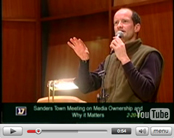Discuss E-List
Essential Resources Guide
FREE Teaching Resources
Membership Benefits
Partner Discounts
Summit 2006
Start an ACME Chapter
Building Synergy in Your Classrooms and Communities!
For educators, the easiest way to begin is to simply create an ACME chapter or "club" on your high school, college, or university campus. An annual $100 organizational membership entitles your ACME school chapter to all the benefits ACME provides, including discounts on dozens of multi-media education resources for your school's library.
It is a membership that pays for itself with the purchase of just a few powerful media education resources at discounted prices!
As ACME membership grows in your area, consider forming an ACME local, state or provincial chapter. ACME currently has chapters in Boston, New York City, New Mexico, and Vermont, and planning for ACME chapters is unfolding around the continent.
Structure: ACME chapters (be they provincial, regional, state, or local) agree to the ACME’s Code of Ethics and follow the same By-Laws.
Dues from chapter members are payable to ACME, with 50% of dues returning to the chapter, to be used consistently with ACME’s mission and by-laws, determined by the chapter’s elected leadership with approval from a designated ACME national board member.
Chapter leadership will be comprised of (at least) a President, Secretary, and Treasurer, constituting an ACME chapter board.
ACME chapter board members will be elected by ACME members when at least six dues-paying ACME members in good standing are present. The nomination, election, functions of each office, and length of terms will be consistent with those detailed in the ACME By-Laws.
Benefits of Belonging
The benefits of belonging to ACME include:
Listing of organizations and individuals on the ACME web site, including brief descriptions of their work/services offered and contact/website information.
Discounts on media education curricula and resources, including books, CDs, and videos from ACME coalition members.
Application for the ACME curriculum standards.
A discount on ACME Summit registration, plus attendance at the featured speakers’ "Members Only" round-table discussions.
Discounts on media education and activism trainings and seminars provided by the ACME Board of Directors and Advisory Board members.
Nine Beginning Steps
1. MAKE INITIAL CONTACTS: Determine ACME members living in your region and make contact. Create a communications network and begin the conversation by finding out what they are working on, what their media (education, independent production, activism) goals are, what the community needs, and how you might begin to work together.
2. BEGIN A DIALOGUE: Usually, there are several people in the community who all want to see the same thing happen, and are working on different parts of the problem. What is usually lacking is a coordinated effort...folks are sometimes unaware of who is doing what, or how so and so could help with their project...the aim of bringing everyone together is to begin the dialogue. A communications network (an e-mail distribution list, for example) is critical!
3. IDENTIFY SPECIFIC PROJECTS: People generally will come together to discuss something specific, or begin working on a specific project. It’s critical to identify what the media issues are in your area...FCC deregulation, media coverage of the war, and Clear Channel firing local DJ’s are all current issues that make media matter to many folks. Other topics may be getting media education in to the local schools, or getting Channel One out of your local school. Whatever is of most interest to your community should be your first topic.
4. HOST A MEETING: Using the resources of people you’ve contacted, pick a central location and generally good time for a meeting. Evenings (right after work) generally work for most people, though sometimes mid-day can work too. Make your invitations topic-focused and solution oriented. If possible, bring food...it makes people feel comfortable.
5. INTRODUCE EVERYONE AND COLLECT CONTACT INFO: Begin the meeting by identifying yourself, what you do, and why you called the meeting, and then ask people to introduce themselves and say what they do and why they came. Begin a sign-in sheet for each person to list their name, organization, and email, and circulate it around the room.
6. DETERMINE AREA(S) OF GREATEST NEED AND BEST MEANS OF SUPPORT: It helps if you go in prepared with not only the problem you’re identifying, but some research regarding what other communities or organizations are doing about it. If someone in your community is already taking actions to address the problem, your focus may be to begin coordinating efforts, and offer support.
7. RUN A TIGHT AND FOCUSED MEETING: Keep the meeting within the time allotted (2 hours is usually good). Make sure you conclude the meeting after you’ve determined next steps and a second meeting time (to discuss progress and further strategize). Also ask individuals and organizations to forward you any information regarding media events or projects they are currently sponsoring, so you may distribute the information to all who attended the meeting. Make sure everyone has your name, email, and phone.
8. MEETING FOLLOW UP: Always follow up by sending attendees the meeting minutes, listing actions steps and the date of your next meeting. Make sure you list all emails in the BCC header, as many people do not want their emails to become public. If folks send you information to distribute to the group, do so (but only it’s media-focused and relevant to your objectives in working together – otherwise people will stop reading your emails).
9. REGULAR REMINDERS: Finally, make sure you remind folks about your next meeting several days before you are planning to have it. Scheduling a meeting a month ahead is great for planning, but terrible for those of us suffering from memory loss (or just plain busy lives).
Download a PDF version of this document



![View your cart items []](/sites/default/modules/ecommerce/cart/images/cart_empty.png)





